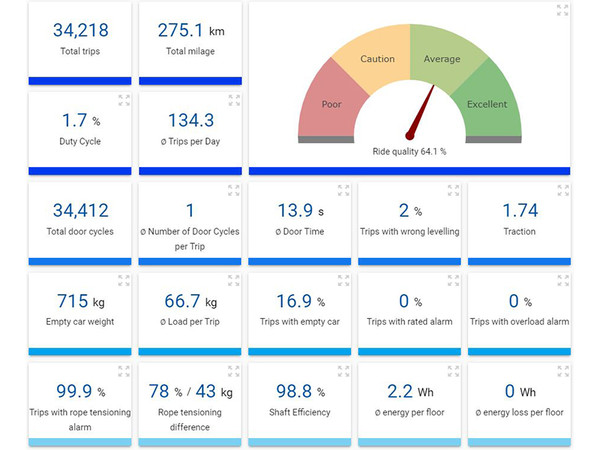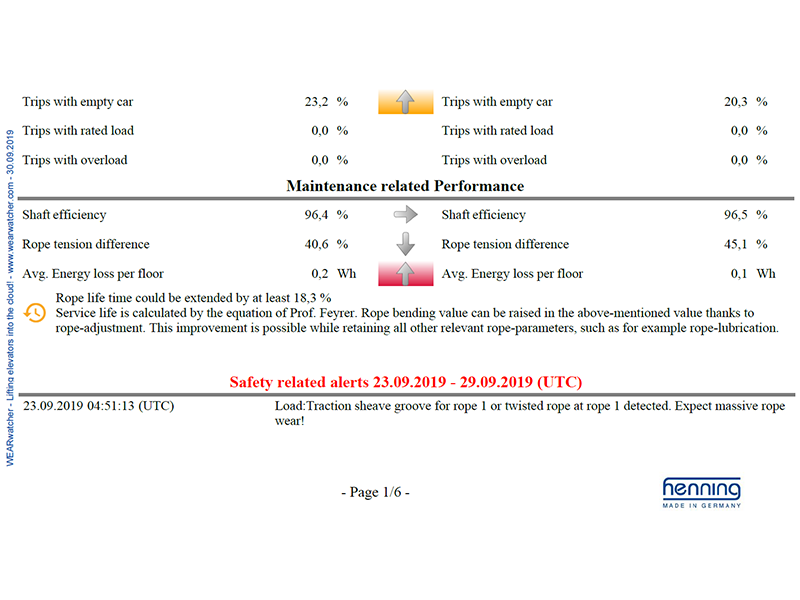The special feature of the Wearwatcher are the algorithms
How far is the development of predictive maintenance? The fifth hardware generation of Henning's Wearwatcher is designed to detect actual component wear locally on the elevator – without connecting to the cloud.
Several sophisticated design concepts, coupled with artificial intelligence, have already brought the goal of predictive maintenance significantly closer. They can detect actual component wear. The fifth hardware generation of the Wearwatcher has the efficiency to implement such design concepts locally at the lift – without the necessity of a data connection to the cloud.
Digitalisation on the lift market is advancing. Ilot (Industrial Internet of Things) for lifts is still often restricted to monitoring functions, which could also be achieved with the remote connection of a controller.
Many years of experience
Henning GmbH & Co. KG already developed the first condition monitoring device for lifts in cooperation with BASF in 2004. This was long before intelligent sensor data use for machine monitoring and maintenance became known as "Industry 4.0". However, the forerunner of the first Wearwatcher system arrived on the market too early and as is well-known, this took care of itself: supply on its own does not create any demand.
Nevertheless, Henning continued to pursue monitoring for lifts. In 2012, we redesigned it based on technologies and concepts that had in the meantime become available. Many years of experience in acceleration and load measuring technology for lifts helped us and had a decisive influence on the development of novel algorithms for wear detection.
Cheaper and more efficient
 Numerous statistical indicators, up to and including data points such as shaft efficiency and traction capacity, already offer helpful monitoring functions. Photo: © Henning GmbH & Co. KG
Numerous statistical indicators, up to and including data points such as shaft efficiency and traction capacity, already offer helpful monitoring functions. Photo: © Henning GmbH & Co. KGThe more complex and intelligent algorithms become, the greater too the resource requirement, especially when it comes to computing power. Normally, resort is had to the cloud to provide adequate computing performance for the current neuronal networks. The data required ("big data") needed to generate the neuronal networks are also stored there.
This concept has a decisive defect: the raw data of all sensors first has to be transported to the cloud. This is expensive with M2M mobile communications solutions and often far more inefficient than for example normal monthly lift maintenance.
Genuine edge computing
So-called "edge computing" promises to help. Here the data are already processed in the device in the lift. This is often just pre-processing of the data, which are compressed or filtered. This reduces the data volume, but hundreds up to thousands of megabytes are still transmitted via mobile communications connections. The solution for this is "genuine edge computing" in a form where almost all of the data processing takes place in the device.
Only alarms, maintenance information and if applicable statistics are transmitted to the cloud. This is possible even if in the case of neuronal networks the question immediately arises how this is to work without "big data" access.
The answer is: not at all! This is because the data flood is "only" needed for the generation of neuronal networks, but not for their implementation. Consequently, it is enough to keep the data volumes in the cloud at particular times. As soon as the neuronal networks have been formed and trained, you only need the data of the investigation object (in this case, the specific lift) and ample computing performance.
What are special are the algorithms
The fifth hardware generation of the Wearwatcher was created taking these considerations into account. The device is a highly integrated board designed for the specific "lift" use case. It integrates the latest chips of reputable manufacturers like NXP.
The 64-bit ARM architecture has:
- up to four cores each with 1.8 GHz processor speed
- additional 32-bit real time CPUs and FPGAs,
- extremely fast LPDDR4 memory,
- an integrated modem and
- optional NPU.
As a result, neuronal networks and other intelligent algorithms can be executed directly on the device and only notifications are sent to the cloud with the integrated LTE modem.
Algorithms detect wear of components
 Photo: © Henning GmbH & Co. KG
Photo: © Henning GmbH & Co. KGMany devices offer monitoring-/ statistical information and lift attendant functionalities (trip and door movement meters, landing and capacity utilisation statistics, door and travel times, flush stopping, etc.). The special feature of the Wearwatcher are the algorithms. Thanks to the powerful hardware, these detect the wear of components directly in the lift and communicate these together with recommended actions via the cloud to the user.
This is the basis for predictive maintenance. The device even fully automatically and reliably detects wear phenomena that the fitter on the spot can hardly identify – such as incipient wear in a traction sheave groove, which would lead to enormous rope wear. On top of this is the monitoring of safety-relevant factors, such as the keeping track of the effectiveness of various braking installations of a lift and the traction capacity.
By Tim Ebeling
The author is the managing director and head of development at Henning GmbH & Co. KG.
More information: wearwatcher.com























Write a comment